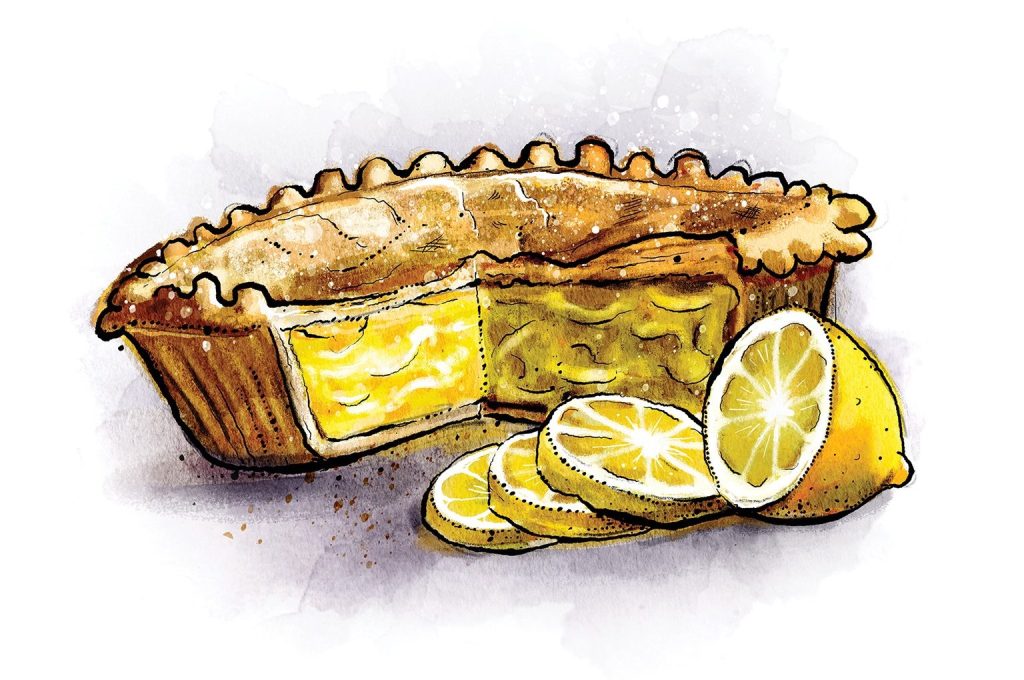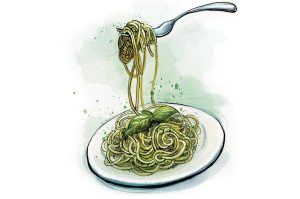Cooking in January is a very different beast to cooking in December. I don’t just mean the flavors (the dried fruit and spice, and dark, boozy, rich flavors of the festive period are relegated to the backs of pantries and drinks cabinet) or even the sentiment, whereby many will look to lighter, simpler dishes to counteract the previous month’s excess. The process is different too. My January kitchen is quiet, the cooking or baking less frantic than that of the weeks that preceded it. It’s not performative, and there are no gargantuan grocery deliveries that require half an hour of fridge Tetris. There is no deadline and my days are less full, so baking is a pleasure which punctuates them, rather than an item on a to-do list. The baking becomes an end in itself.
The filling is anything but one-note: it is complicated and compulsive, and definitely very grown-up
I find the process of making pastry — especially pastry which is designed to flake or crumble, that needn’t have pin-neat edges, or perfect layers — soothing. Whether it’s the act of rubbing the butter into the flour between my fingers, judging the moment when the two are properly combined, or the rolling out of the dough, transforming it from a slightly shaggy mess into a smooth sheet that will fit snugly in a pie dish, pastry-making always feels like a new beginning. And, particularly in the new year, the act of making my own pastry feels like a quiet resistance against the clamor of diets and the self-flagellation that January often brings.
I always like to start the year with a citrusy recipe. Initially it was an unconscious move away from festive flavors but soon it became deliberate, a way of ushering in the New Year with something fresh, something different from the recent mainstays of my kitchen. This year I have taken the citrus to its logical conclusion, and made a Shaker lemon pie, an old-fashioned American pie that contains almost the whole lemon.
The pie — and its name — originated with the Shakers, a branch of Christianity that emerged in nineteenth-century England, and then became established in living and working communities in America. The Shakers were known for their frugality, craftsmanship and self-sustainability. The defining characteristic of a lemon Shaker pie is the use of the juice, flesh, pith and peel, which fits with the no-waste Shaker way of life.
Consequently, it is unlike any pie you’ve ever eaten before. The pastry is a classic, barely sweetened American-style pie dough. As you assemble the pastry, the butter will still appear in large, visible lumps, which leads to the distinctive crisp, flaky texture and rich flavor you’re seeking. But the filling, by contrast, while soft and luscious, is shockingly sharp and fantastically lemony.
Traditionally, the lemons are cut into slices as finely as possible, peel and all, with just the pips removed. They’re then left in the sugar to macerate. Where the pie originates, Meyer lemons would be used, which have thinner peel and are slightly less sour. It’s almost impossible to get hold of these in Europe, so I use standard lemons, but increase the maceration time significantly. By the time the lemons have had their time, they will have softened and broken down, and given up their juices, which in turn will have dissolved the sugar, creating a fantastic lemon syrup. Eggs and a small amount of flour are all that’s needed to turn this mixture into a cohesive pie filling.
It reminds me of a lemon marmalade, but it’s fresher than that, and looser, custardy even, thanks to the eggs and its long maceration and comparatively short cooking time. Like marmalade, though, the combination of the naturally sharp citrus oils and a lot of sugar allows all the fruit’s natural qualities to come to life. The filling is anything but one-note: it is complicated and compulsive, and definitely very grown-up. Cream is a good counterpoint to the intense filling, whether that’s my old favorite, thick pouring cream, or the classic, squirty whipped cream from a can.
Takes 1 hour, plus macerating time
Bakes 45 mins
Serves 6-8
For the pie dough and glaze
– 1¼ cup plain flour
– Pinch of salt
– ¼ cup superfine sugar
– 3 oz cold water
null
– 1 cup cold butter, ½ inch cubes
– 1 egg
– 2 tsp demerara sugar
For the filling
– 3 lemons
– 1¼ superfine sugar
– 3 large eggs
– 1 large egg yolk
– ½ tsp salt
– ⅛ cup plain flour
- Slice the lemons as thinly as possible while keeping them in rounds, discarding the pips as you go.
- Place the slices with the sugar in a bowl, cover and macerate overnight.
- Stir the salt and sugar through the flour in a large bowl. Rub the butter into the flour until the largest pieces of butter are the size of hazelnuts and the smallest the size of peas. Stir through the water until the dough comes together. Wrap in Saran Wrap and refrigerate until ready to use.
- Preheat the oven to 430°F/400°F fan.
- Flour a work surface and divide the dough into two balls, one twice the size of the other. Roll out the larger ball in a circle to the thickness of a coin, big enough to cover your pie dish with a one-inch overhang. Roll the pastry up onto a floured rolling pin and then out onto the pie dish. Gently ease the pastry into the dish until it is flush.
- Stir the eggs, egg yolk, salt and flour into the macerated lemons and pour the whole thing into the lined pie dish.
- Roll out the smaller piece of dough into a disc one inch wider than the top of the pie plate. Lay across the top of the pie, and gently squeeze the overhang on the two layers of pastry together; using scissors, trim the overhang to ½ inch. Crimp, pleat or press the tines of a fork along the edge to seal and create a border.
- Brush the pastry with beaten egg and sprinkle with demerara sugar. Cut two vent holes into the top of the pastry.
- Bake for fifteen minutes, then reduce the oven temperature to 380°F/370°F fan, and bake for a further thirty minutes. Leave to cool to room temperature before serving.
This article was originally published in The Spectator’s UK magazine. Subscribe to the World edition here.





















